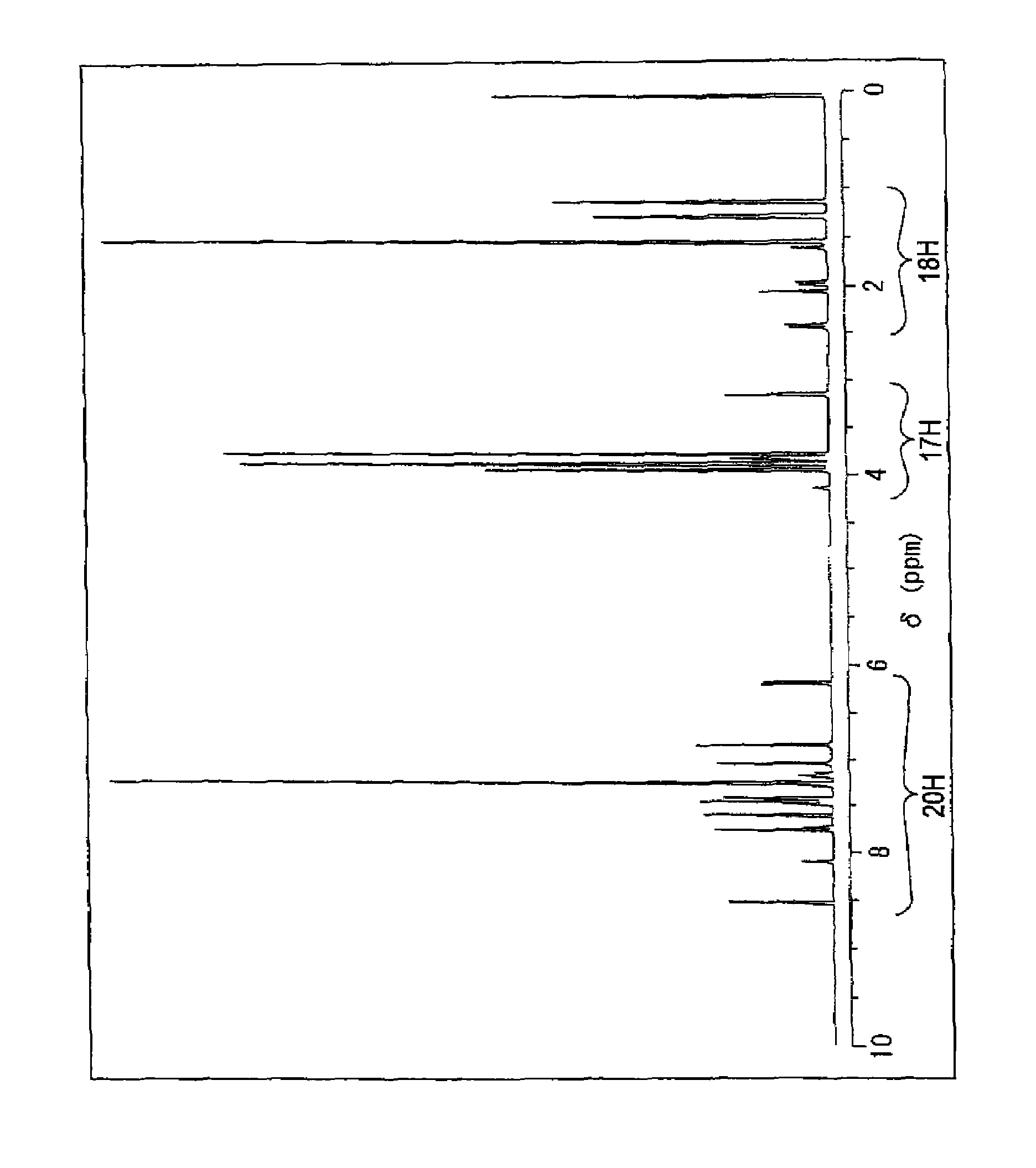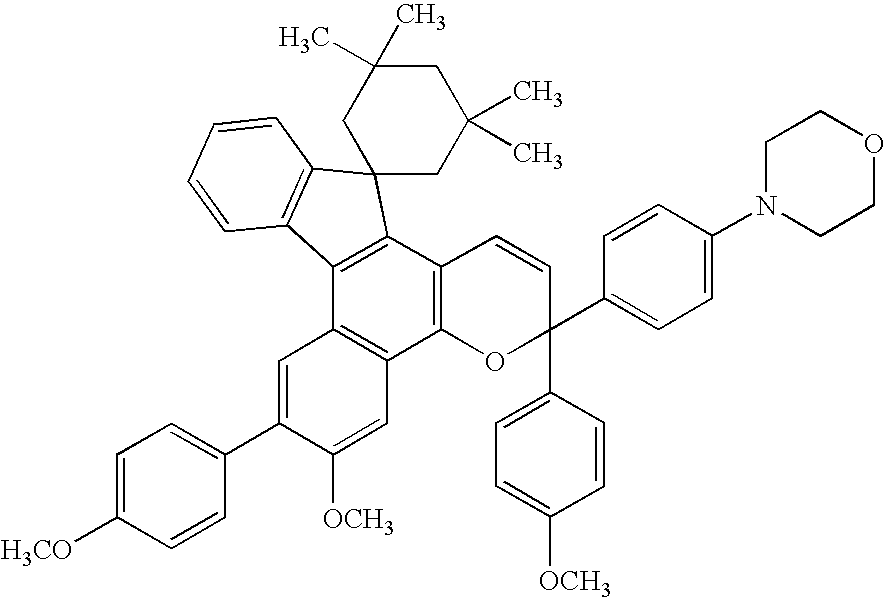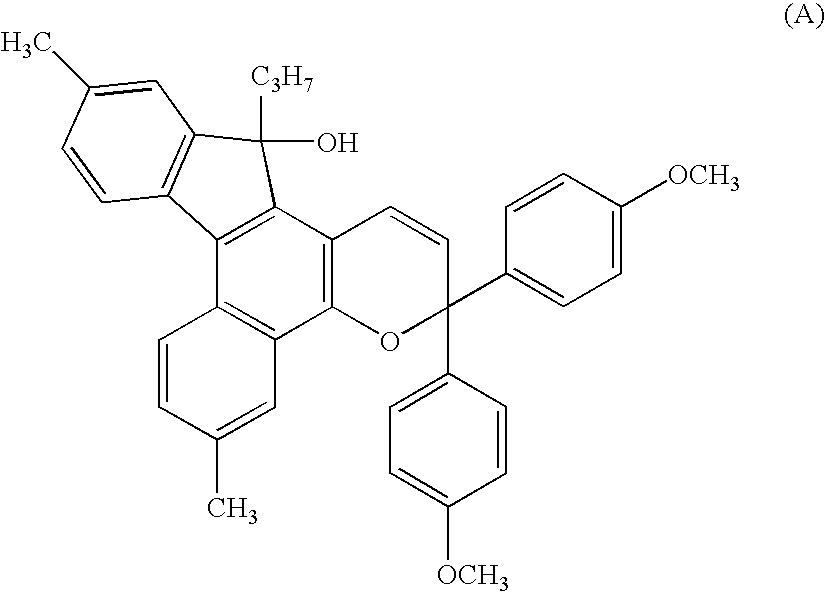Chromene compound
a compound and color technology, applied in the field ofchromene compounds, can solve the problems of yellowish color tone, bluish color tone, yellowish color tone, etc., and achieve the effects of high color density, excellent photochromic properties, and high color development sensitivity
- Summary
- Abstract
- Description
- Claims
- Application Information
AI Technical Summary
Benefits of technology
Problems solved by technology
Method used
Image
Examples
example 1
[0127]1.0 Gram (0.0020 mols) of a 5-hydroxy-(7H)benzo(c)fluorene derivative of the following formula,
[0128]
and 1.1 g (0.003 mols) of a propargyl alcohol derivative of the following formula,
[0129]
were dissolved in 70 ml of toluene to which was further added 0.020 g of a p-toluenesulfonic acid, and the mixture was stirred for one hour while being heated and refluxed. After the reaction, the solvent was removed and the residue was refined by chromatography on silica gel to obtain 1.1 g of a green powdery product. The yield was 70%.
[0130]The product was elementally analyzed to be C: 81.23%, H: 6.92%, N: 1.81%, O: 10.04%, which were in very good agreement with the calculated values (C: 81.27%, H: 6.95%, N: 1.76%, O: 10.02%) of C54H55NO5.
[0131]Measurement of proton nuclear magnetic resonance spectra indicated, as shown in FIG. 1, peaks of 18H near δ: 1.0 to 3.0 ppm based on methyl and methylene proton of a tetramethylcyclohexane ring, peaks of 17H near near δ: 3.0 to 4.0 ppm based on meth...
examples 2 to 41
[0135]Chromene compounds shown in Tables 1, 2, 3, 4, 5, 6, 7, 8, 9 and 10 were synthesized in the same manner as in Example 1. The obtained products were analyzed for their structures relying on the same structure confirmation means as that of Example 1 to confirm that the compounds possessed the structural formulas as shown in Tables 1, 2, 3, 4, 5, 6, 7, 8, 9 and 10. Tables 11, 12 and 13 show elementally analyzed values of these compounds, values calculated from the structural formulas of the compounds, and characteristic spectra in the 1H-NMR spectra.
[0136]In the chemical formulas in Tables below, Me represents the methyl group and Et represents the ethyl group.
[0137]
TABLE 1Ex.Starting materialNo.Benzofluorene derivativePropargyl alcohol derivative2345Ex.YieldNo.Product(%)248328443562
[0138]
TABLE 2Ex.Starting materialNo.Benzofluorene derivativePropargyl alcohol derivative6789Ex.YieldNo.Product(%)635742838935
[0139]
TABLE 3Ex.Starting materialNo.Benzofluorene derivativePropargyl alcoh...
examples 85 and 86
[0191]Though the chromene compounds of Examples 1 to 41 exhibit neutral tints by themselves, the chromene compounds obtained in Examples 1 or 9 were mixed with the following compounds (F), (G) and with the above compounds (B), (D) at compositions shown in Table 19 to obtain more favorable neutral tints.
[0192]
[0193]Further, polymer compositions were prepared in the same manner as in Example 42, and cured coatings were obtained. The obtained cured bodies were left to stand outdoors to develop colors, and the developed color tones were confirmed by naked eyes. The results were as shown in Table 19.
[0194]
TABLE 19Compound composition(wt. pts. / 100 wt. pts. of allDevelopedEx.polymerizable monomers)colorNo.(F)(G)Ex. 1(D)(E)tone850.50.302.300.650.75grey8610.502.000.400.3brown
[0195]The photochromic polymers in Examples 42 to 84 using the chromene compounds of the present invention are superior to the photochromic polymers of Comparative Examples 1, 2, 3, 4 and 5 with respect to all of color-d...
PUM
| Property | Measurement | Unit |
|---|---|---|
| temperature | aaaaa | aaaaa |
| temperature | aaaaa | aaaaa |
| δ | aaaaa | aaaaa |
Abstract
Description
Claims
Application Information
 Login to View More
Login to View More - R&D
- Intellectual Property
- Life Sciences
- Materials
- Tech Scout
- Unparalleled Data Quality
- Higher Quality Content
- 60% Fewer Hallucinations
Browse by: Latest US Patents, China's latest patents, Technical Efficacy Thesaurus, Application Domain, Technology Topic, Popular Technical Reports.
© 2025 PatSnap. All rights reserved.Legal|Privacy policy|Modern Slavery Act Transparency Statement|Sitemap|About US| Contact US: help@patsnap.com



